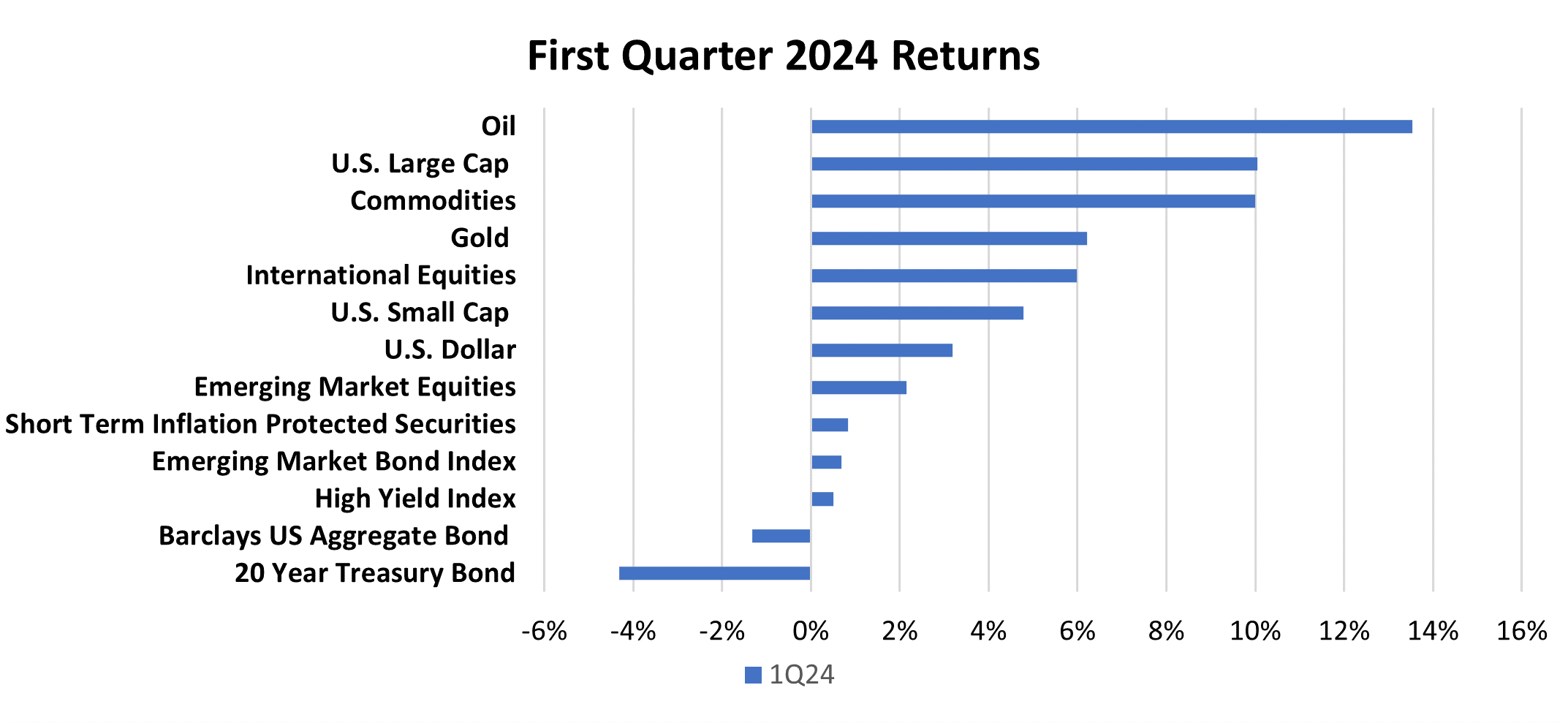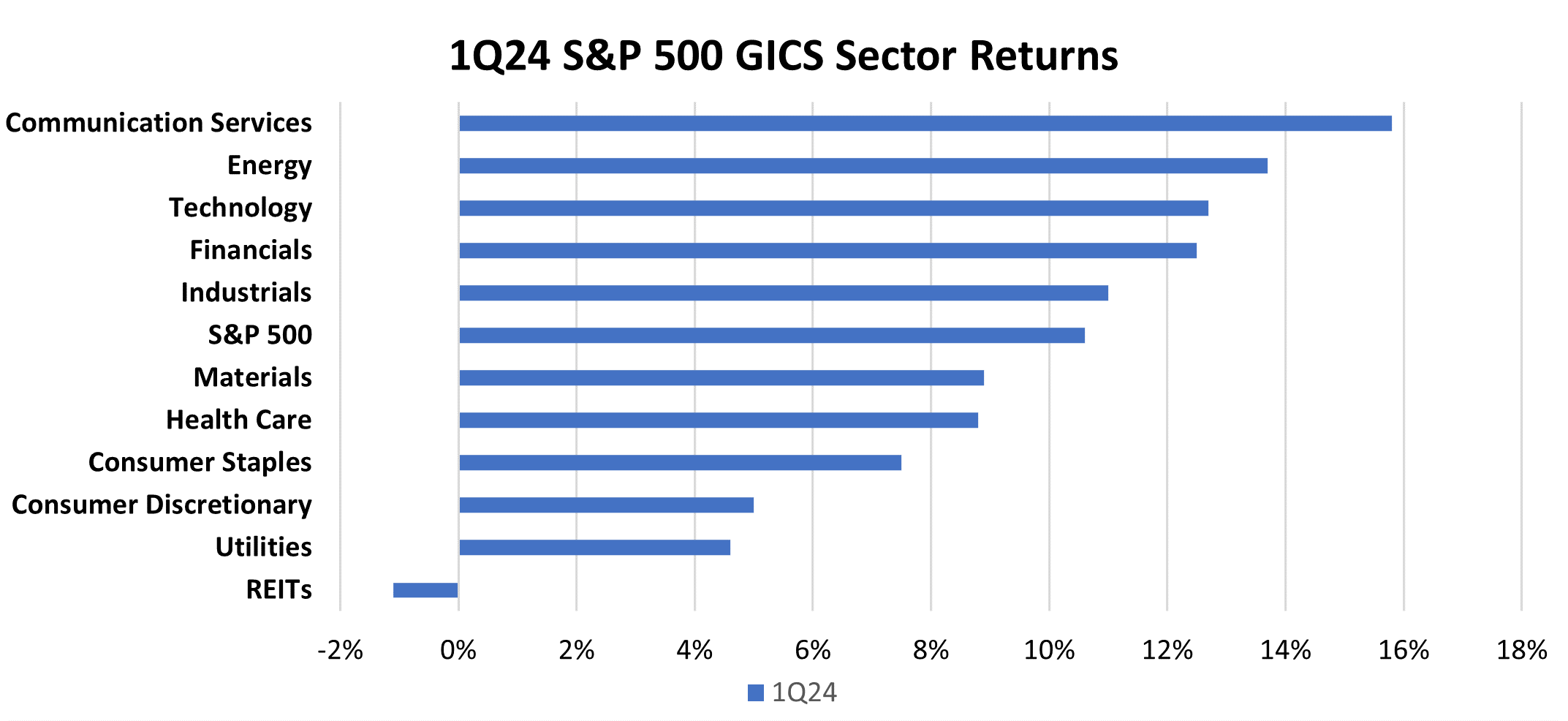Overview
During the quarter the U.S. markets continued an upward trend that began last November when the Federal Reserve indicated that it would start cutting the Fed Funds rate in 2024.[1 ]This accommodative policy has, in part, helped drive global growth and in turn propelled markets to new highs. We now see cash coming off the sidelines into equities and the newly launched Bitcoin ETFs.[2] In our opinion, two themes impacting the markets are the push into artificial intelligence (AI), and accelerated computing. We believe we are in the first inning of the AI transformation that will support higher growth rates in the semiconductor industry. Nvidia, the leader in the space has seen exponential growth over the last few years as a result. On their recent earnings call Nvidia made the following comments about AI.[3]
“The computer industry is making two simultaneous platform shifts at the same time. The trillion-dollar installed based of data centers is transitioning from general purpose to accelerated computing. Every data center will be accelerated so the world can keep up with the computing demand, with increasing throughput, while managing costs and energy.”
“Accelerated computing in turn enables the second transition to “a whole new computing paradigm, generative AI, where software can learn, understand and generate any information from human language…”.
“These two trends will drive a doubling of the world’s data infrastructure installed based in the next five years and will represent an annual market opportunity in the hundreds of billions.”
In its simplest form, AI takes large amounts of data or language and processes it quickly. It can be used in a variety of fields including medicine, financial services, customer service, and warehouse automation in order to improve the productivity of decision making and action. To support AI, a new and expensive infrastructure needs to be established. Everything from computers, semiconductors, servers, storage, data centers, electricity and supporting equipment, plus the know-how in areas of consulting and other engineering fields will increasingly be needed. The total addressable market for AI is conservatively estimated to be approximately $2.1 trillion.[4] As the pie gets bigger there will be increased opportunities for many different companies to participate. While Nvidia has the head start in the core processing of AI, there are several ways for others to meaningfully participate.

U.S. Equity Markets
The U.S. equity markets were positive for the first quarter.[5] Large cap stocks continued to outperform in the first quarter outpacing both mid and small cap stocks.[6] The chart of the S&P 500 has gone parabolic in the last two years driven by the run up in mega cap technology stocks. Almost the entire return of the S&P 500 has been generated by the top 10 stocks in the benchmark. As a result, the valuation of the top 10 stocks is nearly at a record level, while the remaining benchmark holdings have valuations that are relatively tame. In fact, the Financial Times reported that US small cap stocks have suffered their worst run of performance relative to large cap in more than 20 years, highlighting the degree to which investors have chased mega cap technology stocks.[7] Small cap stocks have lagged large cap stocks for the majority of the time since 2016. For the most part small cap has traded at a multiple close to the S&P 500, however it is now trading at a near-record discount. This is reminiscent of what was seen in 1999 and 2000 – after which small cap stocks had strong performance for a decade. Growth outperformed value for the quarter with communication services and technology leading the way. Large investment into and around AI has been driving some traditional growth sectors. Energy and financials, both value sectors, were also top performers for the quarter. Oil prices moved from $71/barrel in December 2023 to over $81/barrel in March.[8] Longer dated bond interest rates increased and the financial sectors benefitted. That same interest rate move impacted the bond proxy sectors such as Utilities and REITs, which were the worst performing sectors for the quarter.

U.S. Fixed Income
The U.S. fixed income market had mixed performance over the quarter. Longer dated interest rates have been fluctuating. In general interest rates have trended higher since the beginning of the year with the 10-year Treasury yield settling around 4.2%, up from 3.9% in December 2023.[9] The S&P U.S. Aggregate Bond Index is down year-to-date 1.63% with longer dated Treasury bonds down more than 5%.[10] There are parts of the bond market that are positive given the higher coupons, such as leveraged loans and high yield. If credit quality holds up, these bonds should perform well.
In previous commentaries we mentioned concern over the debt maturity wall coming due. Given the amount of capital available, many companies have been refinancing their debt at a rapid pace to extend maturities and avoid any near-term issues.[11] While higher interest rates may be a problem for these companies at some point, they have been able to avoid major catastrophe and any big blow ups for now.
Inflation/Interest Rates/Fed Reserve/U.S. Economy
Many have been monitoring closely when the Federal Reserve will decide to cut interest rates. At the last Federal Reserve meeting, the committee kept the Fed Funds rate unchanged at the 5.25% to 5.50% range. However, Chairman Powell indicated that the committee is still targeting three 25 basis point interest rate cuts in 2024.[12] The driving force behind the Fed’s actions has been the combination of a resilient economy and sticky inflation. The latest inflation numbers for February show the Consumer Price Index (CPI) increased by 3.2% and Personal Consumption Expenditures (PCE), which is a different way of measuring inflation, increased by 2.8%.[13] Both wages and rents continue to increase. These inflation levels are above the 2% level targeted by the Fed.[14] The Fed is in an interesting position – they worry about cutting interest rates too soon and having inflation increase again while simultaneously worrying about cutting too late and pushing the economy into a recession. We believe that the Fed will be forced to cut interest rates to support the lower-end consumer. The lower-end consumer tends to borrow the most and whom higher interest rates are having the largest impact. Also, the government has a record level of debt and interest costs have ballooned as interest rates have remained higher.
The U.S. economy has been holding up reasonably well. Fourth quarter GDP grew at 3.2%[15], unemployment remained low at 3.9%[16], retail sales remain positive[17] and the Purchasing Managers Index (PMI)[18], which measures manufacturing activity, is now in expansion mode. We are also hearing from retailers on earnings calls that the lower-end consumer is focused on essential goods like groceries and health care and not spending on discretionary items.
Housing data remains soft, and inventory remains low. New and existing home sales continue to be lower than average because of higher mortgage rates and the unwillingness of sellers to move.[19] New York Times reported that there is a shortage of approximately 4 million homes in the U.S.
Commodities
Another action of note we are watching is the improvement in the Purchasing Manager’s Index (PMI). In 2022 due to supply chain constraints many manufacturers over produced and many companies over bought to make sure that inventory was on-hand and available. Subsequently, a severe de-stocking happened, and manufacturing activity slowed down. Starting late last year manufacturing started to pick up to meet the need of companies restocking inventory. As a result, we are seeing increased demand for oil, copper, and other commodities as inputs into the manufacturing process. Lastly, infrastructure spending has ramped up supported by government subsidized programs.[20]
Europe
The MSCI Europe index was positive for 1Q24, up 7.6%[21], despite the fact that Europe had flat GDP growth for 2023. The U.K. was technically in a recession in the second half of 2023.[22] The EU Commission is forecasting 0.8% GDP growth in 2024 for the Euro countries, which is lower than was originally expected.[23] The EU and UK have faced higher inflation, which has come down as a result of the European Central Bank (ECB) raising interest rates. In our opinion this has impacted credit and economic activity. It is expected that the ECB will start reducing interest rates in the later half of 2024.
China
China’s stock market has continued to underperform and was down -1.5% in 1Q24.[24] While 2023 GDP grew 5.2% year-over-year, the underlying economic activity remains challenged.[25] The property sector has not recovered, retail sales in the fourth quarter were weak and the demographics continue to be a headwind. The Chinese government is optimistic about GDP growing at 5% in 2024, but many economists believe that will be difficult to achieve.[26] However, we are starting to see some improvement with the Chinese PMI just moving into expansion mode[27] and the government has implemented some stimulus measures. After several years of the Chinese stock market underperforming, we may be at a turning point, which is important for the broader emerging markets indices.
Japan
Japan had the best performing stock market in the world during 1Q24, up 16% for the quarter.[28] This came as a big surprise after decades of being the laggard. The Bank of Japan (BOJ) increased its key interest rate from -0.1% to a range of 0% to 0.1%. BOJ increased the rate as consumer prices and wages have increased.[29] Japan has had negative interest rates since 2016. They also utilized yield curve control by buying Japanese government bonds to control interest rates, but they have now abandoned that.[30] The strength in interest rates has caused a depreciation in the Yen, which has supported the rally in the equity markets, and helped make Japan’s exports more competitive.[31] Former Prime Minister Shinzo Abe implemented corporate governance reform, which is now finally paying off.[32] From an investment perspective, it is believed that the corporate governance reform, allowing outsiders to come into Japan, will drive change.
Outlook
We believe that there are opportunities in both the public and private markets. In the equity markets, we are seeing numerous themes including AI, electrification, infrastructure spending, onshoring, and new pharmaceuticals, which excite us with the potential for new opportunities. We believe small cap stocks look particularly attractive after being ignored for several years. On the fixed income side, we are generally seeing higher yields, but we are also seeing alternative lenders step where the banks have exited and are now offering credit and asset-backed fixed income that offer attractive yields and return opportunities. Given the backdrop of the economy being relatively stable and cash flowing into the markets, we believe there are investment opportunities to be found.
